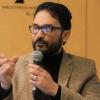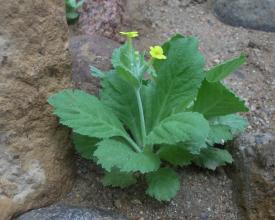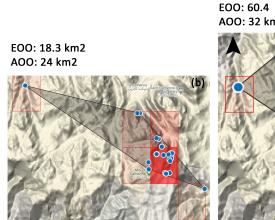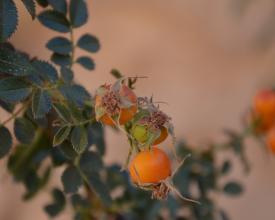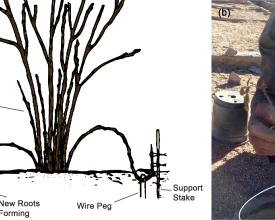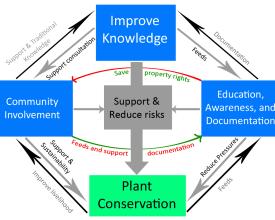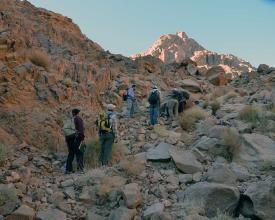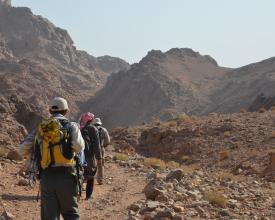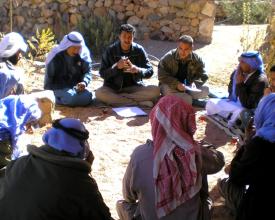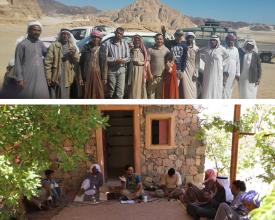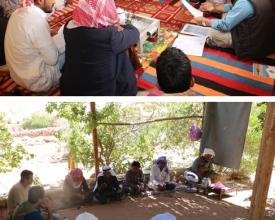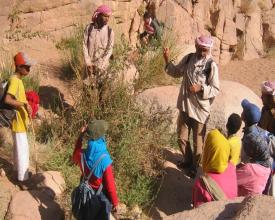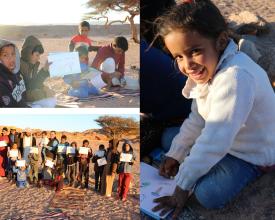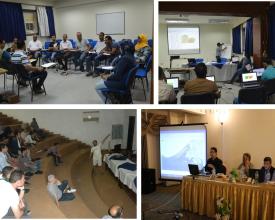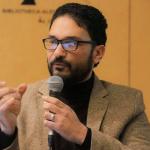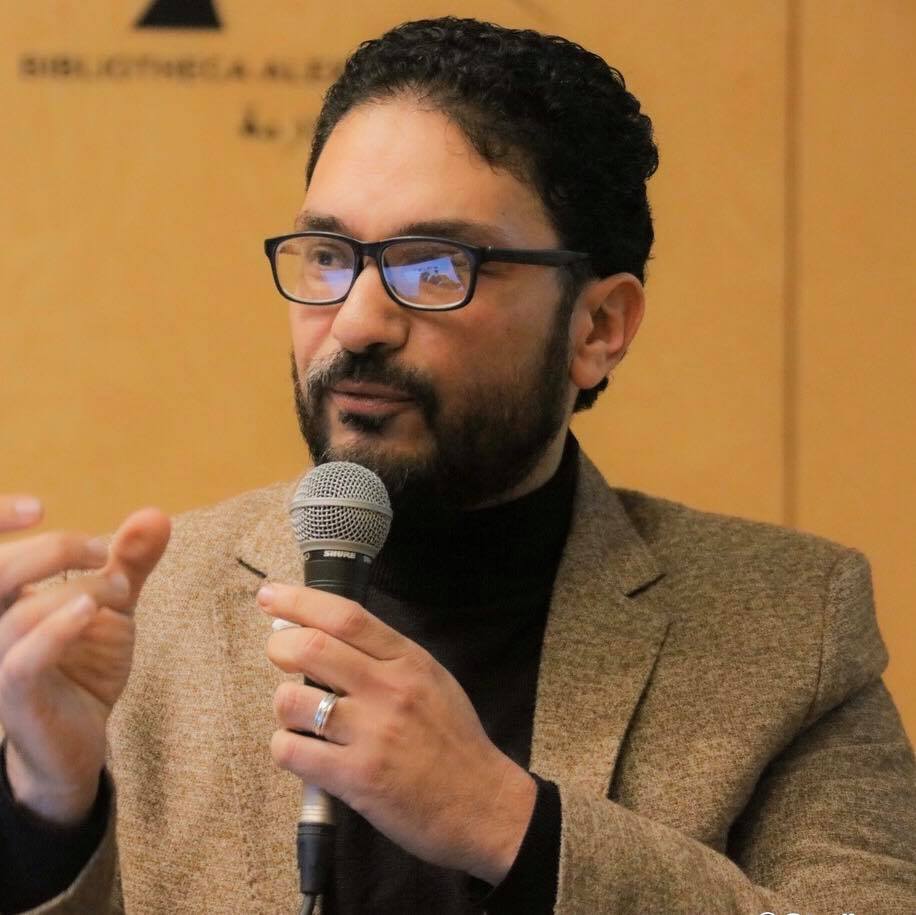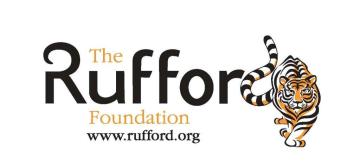
Peut-on sauver des espèces végétales endémiques reliques en danger critique d'extinction ? Une étude de cas des espèces endémiques en Égypte
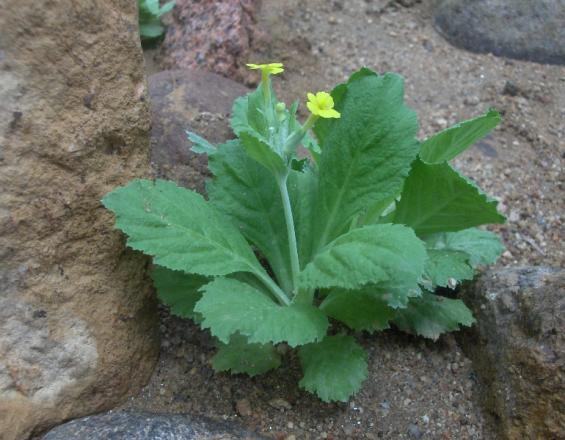
Rosa arabica et Primula boveana sont des plantes vivaces endémiques de la zone de haute montagne de la zone protégée de Sainte-Catherine (SCPA) en Égypte et figurent parmi les 100 plantes les plus menacées au monde. Récemment, elle a été classée dans la catégorie "en danger critique d'extinction" en raison de la faible étendue de son aire de répartition et de la taille réduite de sa population (moins de 90 individus). Le déclin continu de la qualité de l'habitat de cette espèce et la nécessité urgente de mener des actions de conservation sur le terrain ont été signalés. De nombreuses tentatives ont été faites dans le passé pour les cultiver à l'état sauvage, mais elles n'ont pas abouti. Cette solution vise donc à les conserver par des pratiques in situ en mettant en œuvre les étapes suivantes, respectivement : a) Liste rouge de l'UICN, b) Modélisation de la niche écologique, et c) sur la base des deux étapes précédentes, le processus de translocation de R. arabica dans l'habitat approprié sera effectué après avoir réalisé un simple processus de marcottage (méthode traditionnelle de la communauté locale) comme l'une des méthodes végétatives traditionnelles les plus efficaces pour la culture à l'état sauvage de cette espèce.
Contexte
Défis à relever
De nombreuses tentatives ont été faites auparavant pour propager R. arabica dans la nature, mais elles ont été infructueuses, en raison de la difficulté de rompre la dormance de la graine, qui, même après des traitements en laboratoire pendant plus de 16 mois, le taux de germination ne dépasse pas 5 %, et le taux de survie ne dépasse pas 0,5 %. La culture de tissus est coûteuse. Le nombre d'individus dans la nature est en constante diminution et les graines ne germent pas dans la nature. Début 2017, après avoir discuté du problème avec la communauté locale, ils nous ont expliqué une ancienne méthode de multiplication végétative (marcottage) qu'ils utilisent dans leurs jardins en montagne. Et en l'expérimentant à l'intérieur d'un jardin, elle s'est avérée efficace pour produire un nouvel individu à partir de la plante mère (une branche séparée). Après avoir mené des études de terrain sur la répartition des individus, nous avons collaboré avec la communauté locale pour produire de nouveaux individus semblables à la plante mère et les planter séparément dans d'autres endroits afin d'accroître la propagation.
Emplacement
Traiter
Résumé du processus
L'objectif principal est de préserver la ressource naturelle et d'assurer sa durabilité.
1- L'amélioration des connaissances sur les espèces cibles favorise la mise en place d'un programme de conservation précis, alimente les programmes de formation, de sensibilisation et de documentation, et crée un espace de discussion avec la communauté locale sur les étapes de mise en œuvre.
2- L'implication de la communauté locale dans la planification permet d'améliorer les connaissances sur les espèces cibles, de transmettre les connaissances traditionnelles, de réduire les lacunes, d'accroître la confiance, d'assurer la continuité et d'alimenter les programmes de sensibilisation et de documentation.
3- Les programmes d'éducation, de sensibilisation et de documentation réduisent les pressions exercées sur les ressources naturelles, soutiennent les décideurs dans les méthodes traditionnelles de conservation des ressources naturelles et protègent les droits de la communauté locale contre la perte de ces droits à la suite de la mort des chefs de tribus
Blocs de construction
Améliorer les connaissances sur les espèces cibles
Disposer d'informations valables et actualisées sur le statut écologique et de conservation des espèces menacées est l'un des éléments les plus importants pour la mise en place d'un programme de conservation efficace. La collecte de données sur l'aire de répartition géographique actuelle, les caractéristiques de la population, les menaces, l'écologie et l'habitat dans lequel les espèces sont présentes aidera à déterminer l'habitat approprié pour le processus de réhabilitation le plus efficace. La liste rouge de l'UICN est l'un des outils et indicateurs les plus importants pour déterminer l'état de conservation de la diversité biologique dans le monde. De même que les modèles de distribution des espèces (SDM) pour déterminer l'habitat potentiellement approprié pour les espèces cibles.
Facteurs favorables
Pour obtenir les résultats les plus précis de ce bloc, vous devez mener une enquête exhaustive sur toutes les études antérieures, identifier les lacunes et vous efforcer de les combler par des moyens simples et disponibles. Vous devez planifier la manière dont les données seront collectées et les scénarios dans lesquels elles ne pourront pas être obtenues. Votre équipe doit être formée à la collecte des données et à la normalisation des méthodes. Veillez à nettoyer les données avant de les utiliser dans l'analyse. Un examen minutieux par des personnes extérieures à l'équipe afin de garantir l'exactitude des données.
Leçon apprise
L'examen de ce qui a été fait précédemment et l'élaboration d'un plan et d'alternatives avant d'aller sur le terrain est l'un des facteurs les plus importants pour gagner du temps et atteindre l'objectif.
Participation de la communauté locale à la planification de la conservation
Les communautés locales situées à l'intérieur de la zone protégée souffrent de certaines restrictions sur l'utilisation des ressources naturelles, qu'elles considèrent comme leur propriété et leur droit, et qu'elles étaient les habitants de l'endroit avant la création de l'AP. En général, les restrictions sur l'utilisation des ressources naturelles ont pour but de protéger et de réduire les pressions, ce qui peut affecter les moyens de subsistance de certains membres de la communauté locale, qu'ils considèrent comme un processus de déni de leurs droits. La communauté locale possède une richesse culturelle qui a été transmise de génération en génération sur l'utilisation optimale des ressources, leur protection et leur propagation de manière simple. L'implication de cette communauté dans les processus de planification visant à protéger les ressources naturelles éliminera de nombreuses pénalités, que ce soit pour la gestion de l'aire protégée ou pour la communauté elle-même. Les connaissances traditionnelles sont un trésor caché qui peut être utilisé pour améliorer l'état des ressources naturelles et renforcer le sentiment d'appartenance de la communauté locale et l'importance de la protection de ses ressources, ce qui soutiendra le processus de durabilité et réduira les perturbations.
Facteurs favorables
Les personnes chargées du processus de sélection doivent dresser la carte des priorités de la communauté dans ce domaine et des points de discorde, et identifier les leaders communautaires influents, écoutés et appréciés par leur communauté.
Plusieurs réunions initiales devraient être organisées avec les chefs de file de la communauté, afin d'en discuter et de demander leur soutien pour mobiliser la participation de la communauté.
Nous devrions aller les voir dans leur région et organiser des réunions d'assemblée communautaire pour élire des représentants locaux chargés de coordonner les activités du programme de conservation.
Leçon apprise
Nous avons appris que la communauté locale et ses connaissances traditionnelles constituent une richesse scientifique qu'il ne faut jamais gaspiller.
Le processus de sélection des représentants de la communauté locale doit être examiné avec soin, en tenant compte du conflit entre les tribus et en évitant d'impliquer deux parties dissidentes.
Des possibilités alternatives doivent être offertes lorsque la communauté est empêchée d'exercer certaines de ses activités à des fins de conservation
Ils doivent être conscients qu'ils ont le pouvoir de décider et de permettre aux communautés d'établir des priorités et de sélectionner des projets à impact rapide afin de renforcer le soutien et de stimuler la participation locale.
Ressources
Éducation, sensibilisation et documentation des connaissances traditionnelles
Au cours des dix dernières années, nous nous sommes concentrés sur l'évaluation de l'état de conservation des espèces endémiques et sur leur réhabilitation dans la nature. Nous avons fait de gros efforts pour la préserver et planifier sa durabilité. La chose la plus importante à laquelle mon équipe et moi-même sommes parvenus est que la communauté environnante, les utilisateurs des ressources, les chercheurs et les décideurs, qu'ils fassent partie du site ou du gouvernement à l'extérieur, du secteur privé et des étudiants, voire du public, peuvent détruire tout ce que nous avons construit au cours des années précédentes en raison de leur ignorance de notre travail et de son importance pour nous et pour eux. La diffusion de l'information est un bouclier de protection externe qui garantit la durabilité des activités sur le site. Des activités de formation et de sensibilisation continues devraient être organisées dans la zone cible et dans l'ensemble du pays afin d'éviter la destruction due à l'ignorance. De même, ne pas documenter les connaissances traditionnelles héritées par la communauté locale est extrêmement dangereux et leur perte est un gaspillage de richesse qui coûtera à l'État et au monde des sommes considérables à découvrir à nouveau.
L'éducation, la sensibilisation et la documentation pourraient réduire les pressions actuelles et futures, ainsi que l'impact et le coût de la récupération.
Facteurs favorables
Le facteur le plus important pour la réussite des programmes de formation et de sensibilisation est le choix approprié du destinataire, qui est de préférence en contact, de près ou de loin, avec la ressource naturelle.
L'implication de la communauté dans la planification et la mise en œuvre des programmes de conservation et l'accord sur la durabilité et la conservation de la ressource naturelle consolident le principe de partenariat et de confiance et facilitent le processus de documentation de leurs connaissances.
Leçon apprise
Partagez avec la communauté toutes vos prochaines étapes et défis et écoutez leurs opinions et suggestions, même si elles sont simples de votre point de vue.
Enseignez aux enfants de la région pour qu'ils comprennent la nouvelle génération.
Le suivi et l'engagement des stagiaires après la formation et la sensibilisation sont très utiles et permettent d'établir et d'implanter l'information en eux.
Sensibilisez les parties prenantes à l'importance de votre rôle pour leur avenir et partagez la décision avec elles.
Ressources
Impacts
Toutes les étapes mentionnées visent à réduire l'impact des menaces et le risque d'extinction en augmentant la taille de la population, l'étendue de l'occurrence (EOO) et l'aire d'occupation (AOO) en utilisant le savoir traditionnel de la communauté locale.
Rosa arabica : Après un an de translocation dans la nature selon la méthode locale traditionnelle, le taux de survie a varié de 66 à 100 % (10-40 % maximum avec d'autres méthodes), l'aire de répartition géographique a augmenté de 65 % et la taille de la population de 6,8 %.
Primula boveana : Cette étape a permis d'obtenir environ 140 nouveaux individus à ajouter à la population actuelle, soit une augmentation de plus de 25 %. En outre, l'aire de répartition géographique (EOO) après l'ajout des sites de reconstitution a augmenté de 230 %.
Ces étapes, si les nouveaux individus se développent et s'adaptent, peuvent conduire à l'expansion d'autres facteurs environnementaux tels que les facteurs climatiques et topographiques qui augmentent probablement la résilience de la population mondiale de l'espèce face à des événements défavorables.
Outre la dimension environnementale et économique de cette expérience, le succès de la restauration des deux espèces cibles et de leur diffusion par des moyens locaux issus des connaissances traditionnelles est une excellente chose qui reflète l'importance du chevauchement des communautés locales dans les programmes de conservation afin de combler les lacunes et de réduire les conflits et pressions futurs et d'assurer la durabilité.
Bénéficiaires
Réussir la réhabilitation pour la première fois a eu des retombées positives sur l'environnement, l'économie et la société
Bénéficiaires :
Communauté locale (tribu de Gabalia)
Zone protégée de Sainte-Catherine
Secteur de la conservation de la nature
Ministère de l'environnement
Centre de recherche sur le désert
Objectifs de développement durable
Histoire
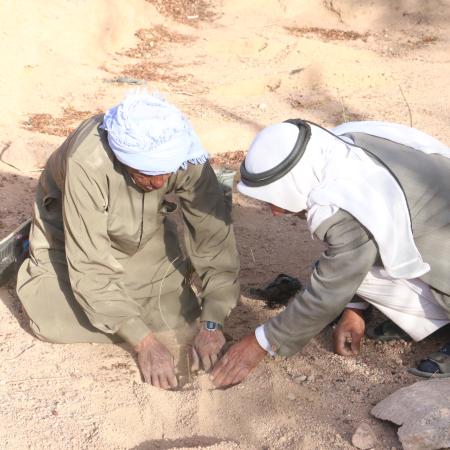
C'est agréable d'avoir l'occasion d'exprimer ce qui est en nous à travers cette expérience. Mon équipe et moi-même avons travaillé dur au cours des 15 dernières années pour sauver ce qui peut l'être de la richesse de notre pays. Nous sommes convaincus que les plantes endémiques sont un trésor national et international pour la science, la société et l'économie. Mais comme les activités humaines continuent à se développer, l'ignorance de la collecte et de la documentation des informations sur l'état de conservation de ces espèces conduira à l'absence d'un plan de conservation, ce qui entraînera l'extinction sans connaissance préalable. Nos études dans cette région nous ont amenés à la conclusion que la priorité de la conservation devrait aller aux espèces les plus sous pression, peu nombreuses et en déclin constant. Avec moins de 100 individus restant à l'état sauvage, le choix s'est porté sur Rosa arabica et Primula boveana. Franchement, nous avons beaucoup essayé de les réhabiliter dans la nature en ignorant l'aide de la communauté locale (nous pensions en savoir plus), mais nous avons complètement échoué. Les processus de germination en laboratoire n'ont pas abouti, pas plus que la culture en serre, et nous avons passé des années à attendre un résultat décevant. Par hasard, lors de discussions avec la communauté locale, une personne a pris la parole et a déclaré : "J'en ai déjà cultivé dans mon jardin". Nous sommes restés bouche bée et nous lui avons dit : "Pourriez-vous nous apprendre comment vous avez fait ? Nous avons tenté une expérience dans son jardin et nous avons réussi à faire germer un nouvel individu avec les caractéristiques de la mère et la capacité de s'adapter. À partir de ce moment, la communauté locale a été le principal partenaire du processus de réhabilitation, dans lequel le taux de survie a atteint entre 80 et 100 %. Nous avons suivi la méthode locale traditionnelle (simple stratification) utilisée par les Bédouins des montagnes pour sauver l'une des espèces les plus menacées au monde, méthode qui s'est avérée rentable dans les régions arides. Dans une société bédouine tribale qui vit à l'intérieur d'une aire protégée régie par le gouvernement avec des ressources financières insuffisantes, il en résulte toujours un conflit sur la propriété des ressources. Outre les avantages environnementaux liés à la réussite du programme de réhabilitation, celui-ci a apporté le plus grand bénéfice à la société et au gouvernement représenté dans la gestion de l'AP, à savoir la participation et le sentiment de l'importance de son rôle et de sa responsabilité dans la protection de ses ressources naturelles, ce qui garantit sa durabilité en protégeant la communauté elle-même. C'est la meilleure chose que nous puissions faire pour notre pays.
